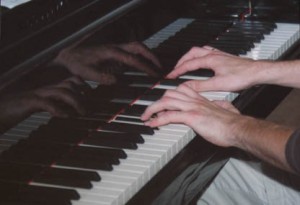On 23 January 2023, I was fortunate to see a concert at the Wigmore Hall in London of four piano hands, those of Lucas Jussen and Arthur Jussen. The programme of the Jussen brothers comprised:
Continue reading ‘Pianos with attitude’
Archive for the ‘Hands’ Category
Page 0 of 3
Friends Best
The streaming series Young Royals, produced by Netflix Sverige, is a coming-of-age story about teenagers with the unusual feature that the main actors are themselves only teenagers. (Most series aimed at teenagers seem to employ actors in their twenties.) Because of this focus, the reviews of the series I have seen are aimed at parents deciding whether or not they should allow their teenage children to watch it.

Bristol life
Bristol 28 vs. Worcester Warriors 20, Ashton Gate Stadium Bristol, Boxing Day 2016. Gate of 16K.
Hackathon life
At the first Internet of Things and Distributed Ledgers Hackathon, Barclays Rise Hackspace, Notting Hill, London, 7 November 2015.
Mao Tse Tung, music teacher
Learn to “play the piano”. In playing the piano, all ten fingers are in motion; it will not do to move some fingers only and not others. However, if all ten fingers press down at once, there is no melody. To produce good music, the ten fingers should move rhythmically and in co-ordination. A Party committee should keep a firm grasp on its central task and at the same time, around the central task, it should unfold the work in other fields. At present, we have to take care of many fields; we must look after the work in all the areas, armed units and departments, and not give all our attention to a few problems, to the exclusion of others. Wherever there is a problem, we must put our finger on it, and this is a method we must master. Some play the piano well and some badly, and there is a great difference in the melodies they produce. Members of Party committees must learn to “play the piano” well.”
Mao Tse-Tung [1949-03-13]: Methods of Work of Party Committees. Selected Works, Vol. IV, p. 379. The hands are those of Hungarian jazz pianist, Szabo Daniel.
Go West, young man
I was headed out down a long bone-white road, straight as a string and smooth as glass and glittering and wavering in the heat and humming under the tires like a plucked nerve. I was doing seventy-five but I never seemed to catch up with the pool that seemed to be over the road just this side of the horizon. Then, after a while, the sun was in my eyes, for I was driving west. So I pulled the sun screen down and squinted and put the throttle to the floor. And kept on moving west. For West is where we all plan to go someday. It is where you go when the land gives out and the old-field pines encroach. It is where you go when you get the letter saying: ‘Flee, all is discovered.’ It is where you go when you look down at the blade in your hand and see the blood on it. It is where you go when you are told that you are a bubble on the tide of empire. It is where you go to grow up with the country. It is where you go to spend your old age. Or it is just where you go.
It was just where I went.”
Robert Penn Warren [1946]: All the King’s Men. Harcourt, Brace and Company.
Mathematical thinking and software
Further to my post citing Keith Devlin on the difficulties of doing mathematics online, I have heard from one prominent mathematician that he does all his mathematics now using LaTeX, not using paper or whiteboard, and thus disagrees with Devlin’s (and my) views. Thinking about why this may be, and about my own experiences using LaTeX, it occurred to me that one’s experiences with thinking-support software, such as word-processing packages such as MS-WORD or mark-up programming languages such as LaTeX, will very much depend on the TYPE of thinking one is doing.
If one is thinking with words and text, or text-like symbols such as algebra, the right-handed folk among us are likely to be using the left hemispheres of our brains. If one is thinking in diagrams, as in geometry or graph theory or much of engineering including computing, the right-handed among us are more likely to be using the right hemispheres of our brains. Yet MS-WORD and LaTeX are entirely text-based, and their use requires the heavy involvement of our left hemispheres (for the northpaws among us). One doesn’t draw an arrow in LaTeX, for example, but instead types a command such as \rightarrow or \uparrow. If one is already using one’s left hemisphere to do the mathematical thinking, as most algebraists would be, then the cognitive load in using the software will be a lot less then if one is using one’s right hemisphere for the mathematical thinking. Activities which require both hemispheres are typically very challenging to most of us, since co-ordination between the two hemispheres adds further cognitive overhead.
I find LaTeX immeasurably better than any other word-processor for writing text: it and I work at the same speed (which is not true of MS-WORD for me, for example), and I am able to do my verbal thinking in it. In this case, writing is a form of thinking, not merely the subsequent expression of thoughts I’ve already had. However, I cannot do my mathematical or formal thinking in LaTeX, and the software is at best a tool for subsequent expression of thoughts already done elsewhere – mentally, on paper, or on a whiteboard. My formal thinking is usually about structure and relationship, and not as often algebraic symbol manipulation.
Bill Thurston, the geometer I recently quoted, said:
I was interested in geometric areas of mathematics, where it is often pretty hard to have a document that reflects well the way people actually think. In more algebraic or symbolic fields, this is not necessarily so, and I have the impression that in some areas documents are much closer to carrying the life of the field.” [Thurston 1994, p. 169]
It is interesting that many non-mathematical writers also do their thinking about structure not in the document itself or as they write, but outside it and beforehand, and often using tools such as post-it notes on boards; see the recent article by John McPhee in The New Yorker for examples from his long writing life.
References:
John McPhee [2013]: Structure: Beyond the picnic-table crisis. The New Yorker, 14 January 2013, pages 46-55.
William F. Thurston [1994]: On proof and progress in mathematics. American Mathematical Society, 30 (2): 161-177.
Mathematical hands
With MOOCs fast becoming teaching trend-du-jour in western universities, it is easy to imagine that all disciplines and all ways of thinking are equally amenable to information technology. This is simply not true, and mathematical thinking in particular requires hand-written drawing and symbolic manipulation. Nobody ever acquired skill in a mathematical discipline without doing exercises and problems him or herself, writing on paper or a board with his or her own hands. The physical manipulation by the hand holding the pen or pencil is necessary to gain facility in the mental manipulation of the mathematical concepts and their relationships.
Keith Devlin recounts his recent experience teaching a MOOC course on mathematics, and the deleterious use by students of the word-processing package latex for doing assignments:
We have, it seems, become so accustomed to working on a keyboard, and generating nicely laid out pages, we are rapidly losing, if indeed we have not already lost, the habit—and love—of scribbling with paper and pencil. Our presentation technologies encourage form over substance. But if (free-form) scribbling goes away, then I think mathematics goes with it. You simply cannot do original mathematics at a keyboard. The cognitive load is too great.
Why is this? A key reason is that current mathematics-producing software is clunky, cumbersome, finicky, and not WYSIWYG (What You See Is What You Get). The most widely used such software is Latex (and its relatives), which is a mark-up and command language; when compiled, these commands generate mathematical symbols. Using Latex does not involve direct manipulation of the symbols, but only their indirect manipulation. One has first to imagine (or indeed, draw by hand!) the desired symbols or mathematical notation for which one then creates using the appropriate generative Latex commands. Only when these commands are compiled can the user see the effects they intended to produce. Facility with pen-and-paper, by contrast, enables direct manipulation of symbols, with (eventually), the pen-in-hand being experienced as an extension of the user’s physical body and mind, and not as something other. Expert musicians, archers, surgeons, jewellers, and craftsmen often have the same experience with their particular instruments, feeling them to be extensions of their own body and not external tools.
Experienced writers too can feel this way about their use of a keyboard, but language processing software is generally WYSIWYG (or close enough not to matter). Mathematics-making software is a long way from allowing the user to feel that they are directly manipulating the symbols in their head, as a pen-in-hand mathematician feels. Without direct manipulation, hand and mind are not doing the same thing at the same time, and thus – a fortiori – keyboard-in-hand is certainly not simultaneously manipulating concept-in-mind, and nor is keyboard-in-hand simultaneously expressing or evoking concept-in-mind.
I am sure that a major source of the problem here is that too many people – and especially most of the chattering classes – mistakenly believe the only form of thinking is verbal manipulation. Even worse, some philosophers believe that one can only think by means of words. Related posts on drawing-as-a-form-of-thinking here, and on music-as-a-form-of-thinking here.
[HT: Normblog]
Feats of memorization

Anthony Tommasini writes in the IHT on the trend to allow concert pianists to play from music, instead of playing recital solos and concertos from memory. A good thing too! While playing from memory is an impressive feat to watch, it certainly takes additional practice effort to achieve: I would rather good performers played more different music than that they played a smaller collection from memory.
I saw Angela Hewitt play the Bach 48 from memory in Cottonopolis a few years ago. At the first concert, a woman in the front row was reading from a miniature score. After the first few preludes and fugues, Ms Hewitt quietly asked the woman to put her score away, as the page turning was distracting. My guess is that the page-breaks were happening at places other than where Ms Hewitt had memorized. (As an aside, her performance was very good but her interpretations undermined by rubato. I prefer my Bach straight, not with flavoured mixers.)
Note: The hands shown are those of Szabo Daniel.
Piano on the Bay
Another colourful outdoor piano, this one by Yunior Marino, spotted at 595 Bay Street at Dundas Street, Toronto. This afternoon some great stride piano was being played on it by an elderly gentleman.
